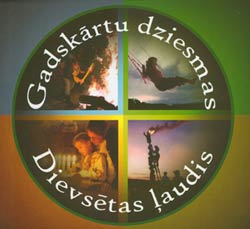
The number of Latvian folk music recordings seems to be growing almost as quickly as wild mushrooms after a rainy summer. Some recordings have specific themes, such as war songs or lullabies, while others cover songs from a certain holiday such as Jāņi or the winter solstice. Until now, I have not been aware of a single recording that attempts to incorporate music of the entire Latvian calendar with all of its holidays. A group of Latvian-Americans has filled exactly this shortcoming. An informative new compact disc, Gadskārtu dziesmas, has recently been released by Dievsētas ļaudis (the folks of Dievsēta).
For 30 years a group of Latvians with a keen interest in folk traditions has been gathering at Dievsēta, a property owned by the Latvju dievturu sadraudze in central Wisconsin, to celebrate holidays—not just the popular Jāņi, but also lesser known ones such as Mārtiņi and Meteņi.
The booklet that accompanies the CD is a treasure trove of information. Its 64 pages include English and Latvian language descriptions of the seven holidays represented by songs on the CD, lyrics and notes for all 43 songs, as well as a number of beautiful photographs from Dievsēta. Each song is also described in one or two succinct sentences in English. The following holidays are represented on the recording: Meteņi (5 songs), Lieldienas (5 songs), Ūsiņi (2 songs), Jāņi (7 songs), Apjumības and Miķeļi (7 songs), Mārtiņi (7 songs) and Ziemassvētki (10 songs).
Glancing at the list of individuals who participated in the CD recording, I noticed names of people who have sung or currently sing with folk ensembles based both in the United States and Latvia. Thus, the quality of the music on the recording is actually quite good. The CD contains a variety of a cappella songs by just one person or a group, as well as songs accompanied by a number of different instruments.
One of the things that I love most about some Latvian songs is the imagery. This is most evident in songs about the sun. The fifth track is a Meteņi song called “Saule savus kumeliņus.” As beautifully summarized by the liner notes, “At sunset the sun takes her horses to the sea to swim, while she herself sits at the top of the hill with the golden reins in her hand.” This song has a simple yet lovely melody. On the CD the song is sung a cappella by just one female, which unfortunately makes it sound a bit too plain. But, with more than three dozen songs on the recording, I did find quite a few songs that I greatly enjoyed.
Many listeners might find track 11, “Tumša nakte, zaļa zāle,” of interest. Listeners might assume this song to be a familiar one, as it is the title of a popular folk song that many children learn in school. Yet, one needs to remember the great diversity in Latvian folk music and thus not be surprised that the melody and—indeed—most of the lyrics of this song are different than the one many people will know.
The seven Jāņi songs have a nice variety of melodies. Anyone who ever tries to sing songs at Jāņi could learn something from these. It seems that most Latvians know only one overused, tired melody for līgo songs. One of the Jāņi songs is sung by children, reminding the listener of the importance of passing traditions down to the younger generations.
Two other songs I greatly enjoyed were “Rudzu druva lielījās” (track 20), a song about work sung at Apjumības, and “Laid iekšā, saimeniece” (track 34), a Ziemassvētki song with a great, party-like tempo and sound.
Many Latvians have never celebrated a holiday such as Miķeli, therefore most songs on the recording will be new to listeners. Even as someone who sings with a Latvian folk ensemble and has participated in a number of folklore activities at 3×3 camps, the majority of songs on this CD were unfamiliar to me. This might be a turnoff for some people, as many individuals seem to prefer the familiar to the unfamiliar. Precisely that is the frustrating thing about Latvian folk music: it is ironic that so many Latvians are familiar with only a couple dozen tunes when the wealth of Latvian folklore is in its folk songs, most of which unfortunately go unsung and unheard.
Because these songs have such specific purposes, this is also probably not the type of CD one would listen to over and over again. However, if one has an interest in Latvian folklore and its traditional holidays and in the diversity of Latvian folk music, and has always wondered how a holiday such as Mārtiņi is celebrated, then Gadskārtu dziesmas will be a wonderful addition to one’s music collection.
Details
Gadskārtu dziesmas
Dievsēta ļaudis
Lauska, 2007
ISBN 978-9984-39-187-8
Where to buy
Purchase Gadskārtu dziesmas from BalticShop.
Note: Latvians Online receives a commission on purchases.
© 1995-2024 Latvians Online
Please contact us for editorial queries, or for permission to republish material. Disclaimer: The content of Web sites to which Latvians Online provides links does not necessarily reflect the opinion of Latvians Online, its staff or its sponsors.





I sang on this album, and I STILL play the CD over & over again! I love the sound of it.
We latvians boast that we have 2.5 million ‘tautas dziesmas’ and 100,000 melodies. REALLY we all should get to know more of them!!
There is information about each seasonal holuday as well -what to do, how to go about celebrating it.
It’s a great CD for families & educational settings as well.